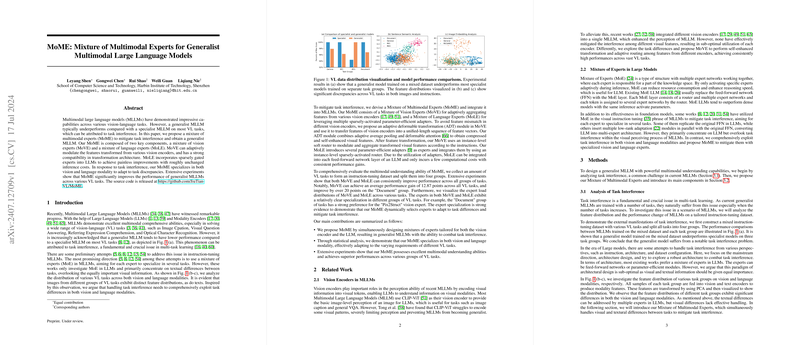Essay on "MoME: Mixture of Multimodal Experts for Generalist Multimodal LLMs"
The paper "MoME: Mixture of Multimodal Experts for Generalist Multimodal LLMs" introduces a novel approach to address the challenges faced by generalist Multimodal LLMs (MLLMs) in handling diverse vision-language (VL) tasks. By using the recently proposed architecture, the authors aim to mitigate the task interference observed in MLLMs and enhance their performance compared to their specialist counterparts.
Key Contributions
The primary contribution of this paper is the development of the Mixture of Multimodal Experts (MoME) architecture. This approach revolves around two critical components: the Mixture of Vision Experts (MoVE) and the Mixture of Language Experts (MoLE). These components are designed to address both visual and textual task discrepancies, thereby reducing task interference.
- Mixture of Vision Experts (MoVE): MoVE comprises multiple vision encoders. The architecture adapts features from these encoders using an adaptive deformable transformation (ADT) module, which aligns disparate visual features and resolves mismatches amongst them. Furthermore, it employs an instance-level soft router to aggregate these aligned features dynamically based on task-specific instructions.
- Mixture of Language Experts (MoLE): MoLE integrates sparsely gated experts into the LLM framework. This minimizes computation cost while simultaneously improving performance. The routing mechanism in MoLE allows for selective expert activation based on the task, ensuring effective adaptation to various vision-language tasks.
Experimental Analysis and Results
The authors meticulously evaluate MoME across a generalized dataset comprising diverse VL tasks, grouped into categories like General, REC, REG, and Document. Their approach demonstrates substantial improvements over existing methods, achieving a notable performance gain, especially in tasks burdened with high task interference. For instance, the MoME model outperforms on average by 12.87 points across all VL tasks, with specific improvements exceeding 20 points in the Document task group.
Theoretical and Practical Implications
Theoretically, the paper bridges the gap in handling both vision and language disparities found in VL tasks within MLLMs. By employing a modality-specific mixture of experts that dynamically adapt based on the task, the model effectively exploits the specialization of different experts.
Practically, the improved performance and reduced inference costs position MoME as a promising architecture for real-world applications requiring robust multimodal understanding. These applications may range from enhanced image captioning systems to more accurate visual question answering models.
Future Directions
The paper sets a foundation for future research into architectures that can learn from multimodal input without succumbing to task interference. Future exploration could investigate scaling this architecture to incorporate additional modalities or adapting the framework to other domains beyond vision-language tasks. Furthermore, extending the MoME architecture to leverage various training paradigms and datasets might reveal additional capabilities and limitations.
In conclusion, the MoME framework marks a substantial step forward in developing generalist MLLMs by effectively managing task interference. This work opens avenues for improved comprehension and performance in multimodal tasks, which are integral to the evolution of AI systems capable of understanding and interacting with the world in a more human-like manner.
